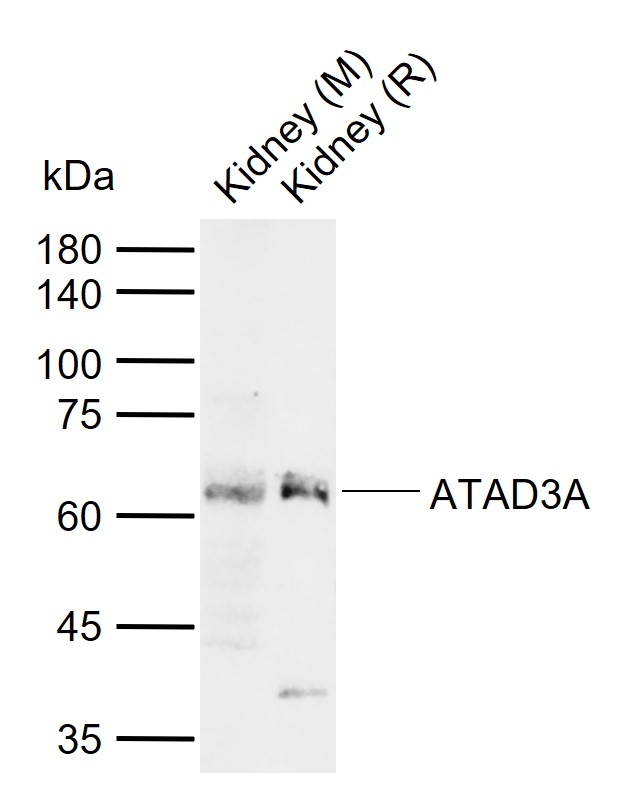
Rabbit Anti-ATAD3A antibody
ATD3A_HUMAN; ATPase family AAA domain-containing protein 3A;
View History [Clear]
Details
Product Name ATAD3A Chinese Name 三磷酸腺苷酶家族蛋白3A抗体 Alias ATD3A_HUMAN; ATPase family AAA domain-containing protein 3A; Research Area Cell biology immunology Immunogen Species Rabbit Clonality Polyclonal React Species Mouse, Rat, (predicted: Human, Pig, Cow, Sheep, ) Applications WB=1:500-2000 ELISA=1:5000-10000 IHC-P=1:100-500 IHC-F=1:100-500 IF=1:50-200 (Paraffin sections need antigen repair)
not yet tested in other applications.
optimal dilutions/concentrations should be determined by the end user.Theoretical molecular weight 71kDa Detection molecular weight 65-71 kDa Cellular localization cytoplasmic The cell membrane Form Liquid Concentration 1mg/ml immunogen KLH conjugated synthetic peptide derived from human ATAD3A: 351-450/634 Lsotype IgG Purification affinity purified by Protein A Buffer Solution 0.01M TBS(pH7.4) with 1% BSA, 0.03% Proclin300 and 50% Glycerol. Storage Shipped at 4℃. Store at -20 °C for one year. Avoid repeated freeze/thaw cycles. Attention This product as supplied is intended for research use only, not for use in human, therapeutic or diagnostic applications. PubMed PubMed Product Detail The AAA ATPase family of molecular chaperones are characterized by a highly conserved AAA motif. Composed of 200-250 residues, the AAA domain contains Walker homology sequences and imparts ATPase activity. Members of the AAA ATPase family act as DNA helicases as well as transcription factors and are thought to be involved in several cellular functions such as cell-cycle regulation, protein proteolysis, organelle biogenesis and vesicle-mediated protein transport. Mitochondrial membrane proteins ATAD3A and ATAD3B contribute to the stabilization of nucleoids which are large mitochondrial DNA (mtDNA)-protein complexes. ATAD3A/B may participate in the transformation pathway and the chemosensitivity of oligodendrogliomas. The genes encoding ATAD3A/B/C maps to human chromosome 1, which houses over 3,000 genes and is the largest human chromosome spanning about 260 million base pairs and making up 8% of the human genome.
Function:
Essential for mitochondrial network organization, mitochondrial metabolism and cell growth at organism and cellular level. May play an important in mitochondrial protein synthesis. May also participate in mitochondrial DNA replication. May bind to mitochondrial DNA D-loops and contribute to nucleoid stability. Required for enhanced channeling of cholesterol for hormone-dependent steroidogenesis.
Subunit:
Can form homooligomers. Homodimer formation at the N-terminus may be regulated by ATP and is required for the interaction with the inner surface of the mitochondrial outer membrane and correct mitochondrial homeostasis. Interacts with components of the mitochondrial ribosome and with other proteins involved in mitochondrial RNA metabolism. May also interact with protein involved in lipid metabolism, including STARD9. May interact with FAM210A. Interacts with GADD45GIP1. Interacts with S100B in a Ca(+2)- and Zn(+2)-dependent manner; this interaction probably occurs in the cytosol prior to mitochondrial targeting. S100B could assist ATAD3A cytoplasmic processing, preventing aggregation and favoring mitochondrial localization. Interacts with HSP60/HSPD1. Forms heterooligomers with ATAD3B; this interaction may affect ATAD3A activity.
Subcellular Location:
Mitochondrion inner membrane; Single-pass membrane protein. Mitochondrion matrix, mitochondrion nucleoid. Note=In the mitochondrial inner membrane, enriched in sites with the potential to form contacts with the outer membrane. The N-terminal domain interacts with the inner surface of the mitochondrial outer membrane and the C-terminal domain localizes in a specific matrix compartment, where it is associated with nucleoids.
Tissue Specificity:
Overexpressed in lung adenocarcinomas (at protein level).
Similarity:
Belongs to the AAA ATPase family.
SWISS:
Q9NVI7
Gene ID:
55210
Database links:Entrez Gene: 55210 Human
Entrez Gene: 108888 Mouse
SwissProt: Q9NVI7 Human
SwissProt: Q925I1 Mouse
Product Picture
References (0)
No References
Bought notes(bought amounts latest0)
No one bought this product
User Comment(Total0User Comment Num)
- No comment



 +86 571 56623320
+86 571 56623320
 +86 18668110335
+86 18668110335

